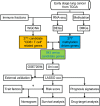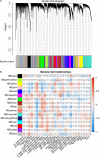A Novel Prognostic Model of Early-Stage Lung Adenocarcinoma Integrating Methylation and Immune Biomarkers
- PMID: 33552145
- PMCID: PMC7859522
- DOI: 10.3389/fgene.2020.634634
A Novel Prognostic Model of Early-Stage Lung Adenocarcinoma Integrating Methylation and Immune Biomarkers
Abstract
Lung adenocarcinoma (LUAD) is caused by multiple biological factors. Therefore, it will be more meaningful to study the prognosis from the perspective of omics integration. Given the significance of epigenetic modification and immunity in tumorigenesis and development, we tried to combine aberrant methylation and tumor infiltration CD8 T cell-related genes to build a prognostic model, to explore the key biomarkers of early-stage LUAD. On the basis of RNA-seq and methylation microarray data downloaded from The Cancer Genome Atlas (TCGA), differentially expressed genes and aberrant methylated genes were calculated with "DEseq2" and "ChAMP" packages, respectively. A Chi-square test was performed to obtain methylation driver genes. Weighted correlation network analysis (WGCNA) was utilized to mine cancer biomarkers related to CD8 T cells. With the consequences of univariate Cox proportional hazards analysis and least absolute shrinkage and selection operator (LASSO) COX regression analysis, the prognostic index based on 17 methylation driver genes (ZNF677, FAM83A, TRIM58, CLDN6, NKD1, NFE2L3, FKBP5, ITGA5, ASCL2, SLC24A4, WNT3A, TMEM171, PTPRH, ITPKB, ITGA2, SLC6A17, and CCDC81) and four CD8 T cell-related genes (SPDL1, E2F7, TK1, and TYMS) was successfully established, which could make valuable predictions for the survival risk of patients with early-stage LUAD.
Keywords: CD8 T cell; lung adenocarcinoma; methylation; prognostic model; survival analysis.
Copyright © 2021 Ren, Yang, Li, Xie, Hu, Qin and Zhang.
Conflict of interest statement
The authors declare that the research was conducted in the absence of any commercial or financial relationships that could be construed as a potential conflict of interest.
Figures








Similar articles
-
Identification of Key Genes Related to CD8+ T-Cell Infiltration as Prognostic Biomarkers for Lung Adenocarcinoma.Front Oncol. 2021 Sep 28;11:693353. doi: 10.3389/fonc.2021.693353. eCollection 2021. Front Oncol. 2021. PMID: 34650911 Free PMC article.
-
Immune-Stromal Score Signature: Novel Prognostic Tool of the Tumor Microenvironment in Lung Adenocarcinoma.Front Oncol. 2020 Sep 23;10:541330. doi: 10.3389/fonc.2020.541330. eCollection 2020. Front Oncol. 2020. PMID: 33072571 Free PMC article.
-
Development of an Oncogenic Driver Alteration Associated Immune-Related Prognostic Model for Stage I-II Lung Adenocarcinoma.Front Oncol. 2021 Jan 28;10:593022. doi: 10.3389/fonc.2020.593022. eCollection 2020. Front Oncol. 2021. PMID: 33585210 Free PMC article.
-
A large cohort study identifying a novel prognosis prediction model for lung adenocarcinoma through machine learning strategies.BMC Cancer. 2019 Sep 5;19(1):886. doi: 10.1186/s12885-019-6101-7. BMC Cancer. 2019. PMID: 31488089 Free PMC article.
-
Screening of Methylation Gene Sites as Prognostic Signature in Lung Adenocarcinoma.Yonsei Med J. 2020 Dec;61(12):1013-1023. doi: 10.3349/ymj.2020.61.12.1013. Yonsei Med J. 2020. PMID: 33251775 Free PMC article.
Cited by
-
Identification of N7-methylguanosine related signature for prognosis and immunotherapy efficacy prediction in lung adenocarcinoma.Front Med (Lausanne). 2022 Aug 24;9:962972. doi: 10.3389/fmed.2022.962972. eCollection 2022. Front Med (Lausanne). 2022. PMID: 36091687 Free PMC article.
-
New insight into the CNC-bZIP member, NFE2L3, in human diseases.Front Cell Dev Biol. 2024 Jul 23;12:1430486. doi: 10.3389/fcell.2024.1430486. eCollection 2024. Front Cell Dev Biol. 2024. PMID: 39149514 Free PMC article. Review.
-
Gene Expression in Bronchial Epithelial Cell Responses to Vanadium Exposure.Biol Trace Elem Res. 2023 Aug;201(8):3774-3790. doi: 10.1007/s12011-022-03461-7. Epub 2022 Nov 5. Biol Trace Elem Res. 2023. PMID: 36334248
-
A Novel Gene Signature Associated with Inflammatory Responses and Immune Status Assists in Prognosis and Intervention for Patients with HCC.J Inflamm Res. 2022 Dec 13;15:6729-6743. doi: 10.2147/JIR.S390113. eCollection 2022. J Inflamm Res. 2022. PMID: 36536645 Free PMC article.
-
Asthma and Post-Asthmatic Fibrosis: A Search for New Promising Molecular Markers of Transition from Acute Inflammation to Pulmonary Fibrosis.Biomedicines. 2022 Apr 28;10(5):1017. doi: 10.3390/biomedicines10051017. Biomedicines. 2022. PMID: 35625754 Free PMC article.
References
-
- Azimi F., Scolyer R. A., Rumcheva P., Moncrieff M., Murali R., McCarthy S. W., et al. (2012). Tumor-infiltrating lymphocyte grade is an independent predictor of sentinel lymph node status and survival in patients with cutaneous melanoma. J. Clin. Oncol. 30 2678–2683. 10.1200/jco.2011.37.8539 - DOI - PubMed
-
- Blanche P., Dartigues J. F., Jacqmin-Gadda H. (2013). Estimating and comparing time-dependent areas under receiver operating characteristic curves for censored event times with competing risks. Stat. Med. 32 5381–5397. - PubMed
LinkOut - more resources
Full Text Sources
Other Literature Sources
Research Materials
Miscellaneous

